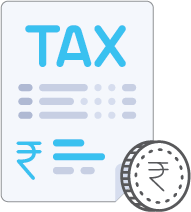
Sales Tax Rate Chart and Computation
Sales Tax in India
Any goods sold or brought in India has a tax levied on it which is referred as Sales Tax. It falls under indirect tax category as the taxpayer does not pay the tax directly to the government but pay it to the collector who later submits it to the government. This tax is usually charged at the time of purchase or exchanging the goods at a certain percentage of the goods value. It is levied by the union government and state government according to Sales tax rules.
The benefits can be listed as below:
- Encourage savings and investment from a person.
- Helps in nation’s economic development.
- Paying tax returns to strengthen your credit history which is much needed while applying for any loans.
Types of Sales Tax
Sales tax are of different types depending on the goods and service types:
- Manufacturers’ Sales Tax: levied on certain goods manufacturing.
- Wholesale Sales Tax: levied on individual dealing with wholesale distribution/sale of manufactured goods.
- Retail Sales Tax: levied on retail sales of goods which are paid directly by the last customer.
- Use Tax: levied on any goods purchased without sales tax from vendors who does not fall under the tax jurisdiction.
- Value Added Tax or VAT: an additional tax levied on all goods sale by governments.
However, sales tax is divided into two major types of rules:
- Central Sales Tax: levied by the union government
- State Sales Tax: levied by the state governments

Central Sales Tax or CST
The central government maintains the taxation laws in this country and the rules are followed as mentioned under Central Sales Tax Act, 1956. This act prescribes tax collection from various goods and it is payable in the state where those goods are being sold.
Objectives of CST:
- To provide legislation for collecting tax from goods sold through interstate trade.
- To provide legislation for levying, collecting and distributing collected tax.
- To determine principles for selling and purchasing goods.
- To classify goods and their importance for selling and purchasing.
- To maintain inter-state trade disputes.
Selling Price
The amount payable for acquiring a product is called as sale price which includes packing cost, insurance charges, incentives and sales tax paid by the dealer etc. no discount or installation cost or delivery cost can be included in it.
Inter-State Sales
Any goods that are transferred or moved between two states for sale is referred as inter-state sale after the sale completes in the destination state.

Various Forms
Dealers need to give a declaration to the buyers in prescribed forms.
There are various forms issued by Sales Tax authority which is defined to use for specific purposes:
- Form C: with this form, purchasing dealer can get goods at concessional rates from the seller.
- Form D: issued to the purchaser of the goods.
- Form E1: the dealer initiating the inter-state movement need to issue this form.
- Form E2: the subsequent seller issue it when goods move between states.
- Form F: when the goods are sent to other states from one, this form will be issued
- Form H: exporters issues this form for purchasing goods.
- Form I: dealers from Special Economic Zones need to issue this forms.

State Government Taxes
State governments can also levy a taxes on certain goods to maintain their financial requirements. The tax rate may differ from goods to goods and in various states with VAT included into it which is a great revenue generator for the states. This is why certain goods have a different price in different states.
Sales Tax Exemptions
Certain exemptions are prescribed into certain goods by various states to avoid double taxation:
- Reselling of goods is exempted from taxes if the seller has state resale certificate.
- A list of essential and local products are exempted from sales tax.
- Products sold to charities and schools are exempted from tax liabilities.
Sales Tax Calculation
Calculating sales tax is complicated, all one need to know is the right formula.
Total Sales Tax = Cost of item x Sales tax rate
The essential point needs to remember while calculating sales tax is:
- It might vary from state to state needs to be paid according to the particular state and city.
- For multiple items, the tax will be calculated after adding all of them.
- It will be calculated in percentage.

Violation of Sales Tax Rules
There are many forms of tax violation and such acts can lead to a penalty for the taxpayer:
- Providing incorrect information in any of the forms.
- Not obtaining the CST act registration certificate and not following the CST act.
- Misappropriation of goods purchased at discounted rates.
- Falsely impersonating a dealer or projection oneself as a dealer.
- Unregistered dealers collecting sales tax from consumers is a violation.
- Providing incorrect statements about purchased goods.
Get the detail process of Direct Tax in India Get Details
Central Board of Direct Taxes
The CBDT or Central Board of Direct Taxes controls the administration of taxes in India and has been declared as a statutory authority and functions under Central Board Revenue Act, 1963 and it works under the Department of Revenue.
The member structure of CBDT:
- Chairman
- Member (Revenue)
- Member (Income Tax)
- Member (Investigation)
- Member (Legislation and Computerization)
- Member (Personnel and Vigilance)
- Member (Audit and Judicial)
Function of CBDT:
It maintains all direct tax collection and related issues in India including the following:
- Works to frame direct tax policies
- Administrate direct tax laws along with the Income Tax Department.
- Process and investigate tax evasion complaints.
 Tax
Tax
 Income Tax
Income Tax
 Sales Tax
Sales Tax
 TDS
TDS
 GST
GST
 Service Tax
Service Tax
 VAT
VAT
 Tax Calculator
Tax Calculator













